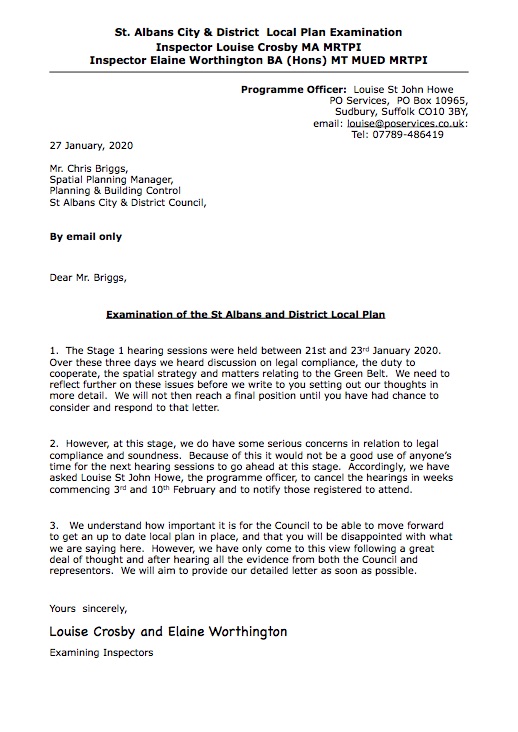CLICK ON THE LINKS BELOW FOR MORE NEWS
2020 in Focus


Jan 3 . Luton Airport Expansion Consultation. First feedback...
Thirty five events were held across the district in Nov/Dec 2019.
4,000 people attended.
People could respond via the official feedback document on line or by post.
1,700 forms were received and are being analysed

Jan 28 Masterplan event packed all evening with local residents keen to question the potential development leading to 580 new homes for NW Harpenden on green belt as part of the SADC draft Local Plan.

‘Our vision is to deliver high-quality infrastructure and homes, including affordable housing, a school, alongside exceptional green spaces and supporting services.’
Jan 22. Harpenden Estate £multi million proposed purchase by SADC.
A good investment for the future of Harpenden’s High Street OR
A reckless idea that could leave ratepayers with an astronomical bill?
Background information
This project has been under internal discussion for many months and is included in the new St Albans Corporate Plan / Budget documents.2020/2024 (available online) St Albans City and District Council Cabinet’s ‘in principle’ decision to purchase the freehold of a property estate in Harpenden was considered by a special meeting of a Scrutiny Committee on Monday 28th October. By keeping the estate under single ownership, the Council will be able to curate the tenant mix to ensure a complementary range of businesses providing services tailored to the wants and needs of local people. In the long term, should the buildings prove to no longer be fit for purpose, the Council will be in a position to regenerate the block taking a place- shaping approach to suit the needs of the locality at that time.
This acquisition will give the Council oversight of a key retail parade at the heart of Harpenden. This will enable the Council to ensure that relatively low-cost retail and office units remain available to local businesses.
Cllr Teresa Heritage, Chairman of the Planning, Housing, Resources and Commercial Scrutiny Committee 2 said
“The issues raised related to the site’s valuation; the level of debt being proposed to fund it; the process followed in arriving at the ‘in principle’ decision to buy; the lack of consultation; and a lack of clarity of aims and outcomes for the acquisition.”
However until the last few days this information has not been broadcast to the public.
Actions from the Harpenden Town Council Extraordinary, CouncilThursday, 24th October, 2019 7.30 pm
+The Town Clerk is to write to the Chief Executive of St Albans City & District Council to express the Town Council’s dissatisfaction with the lack of consultation on the original proposal.
+The Town Council expressed concerns that the case for the purchase being in the public interest is not substantiated because the Business Case focuses entirely on running the Estate for commercial interest.
+The Town Council considers that the papers as presented show no coherent case for how this investment will be managed. This is particularly worrying given the lack of skills and knowledge within the District Council of managing a retail estate of this size. There is also no clear way forward presented for the future rejuvenation of this Estate.
SADC Council Meeting Wednesday, 15th January, 2020 7.00 pm


This is a major ongoing story for the future of the
Harpenden High Street. Harpendia will keep you updated.
Ron Taylor Editor




Jan 28. ‘Serious concerns in relation to legal compliance and soundness’ say examining inspectors of the SADC Local Plan following a week of sessions in St Albans.
IN ADDITION TO THE ABOVE
A further 760 residences would be built to the north of Batford on a site known as ‘North East Harpenden’, again on green belt land.
This draft plan will be examined by the Planning Inspectorate over the next month at Council Chambers in St Albans.
Can Harpenden cope with this massive increase?
More traffic congestion on the Luton Road & Lower Luton rd, parking capacity in the Town, the availability of school places and the impact on Harpenden’s train service.
Not taking into account all the new build that is currently taking place all over Harpenden and thus within the greenbelt, the 1,340 new homes being planned for ‘North West’ and ‘North East’ Harpenden equate to 3,350 new residents at 2.5 residents per household.
Assuming 2 cars per household, there will be an extra 2,680 cars on the Town’s roads.
If only 15% of those car owners want to park in central Harpenden, we will need an extra 402 car parking spaces in a Town which already has insufficient car parking spaces.
Information on the above courtesy of The Harpenden Green Belt Association

SADC planning staff were on hand to explain how the site could be developed with new homes inc many affordable, a school, green spaces and high-quality infrastructure. In response they wanted to hear ideas and priorities on how all these elements would work together, how they would look and how environmentally sustainable they would be.
They were less interested in the legality issues, overdevelopment, contentious issues of excess traffic and lack of services as these would be considered when feed back with opinions had been received and analysed.
Despite being reminded that Local Plan Examining Inspectors had questioned many aspects of the draft plan at the sessions the previous week and had cancelled the final 2 weeks of sessions until satisfactory explanations had been received, they said that this would only be a temporary hitch and the event would provide data for the long term.
Opinions were being collected on an inadequate small form.
HOWEVER the web site is now live with the same data collection questions and images of the display panels which showed various aspects of the site development option.
Please see : www.nwharpenden.co.uk
Follow the 3 stage guide on the right to give your views.

FEB 3. Emsrayne advise Hyde Parish Council that they will not be proceeding with their application for the Incinerator proposal at this time
From the minutes of the January Hyde Parish Council meeting
Andy Brewer provided an update on LBEP – Mr Brewer stated that whilst he had the application ready to submit he would not be proceeding to submit an application at this stage for the Incinerator proposal. Mr E Phillips also provided an overview of the situation regarding the Luton Hoo Estates Management. He gave a brief history of the estates. He confirmed that they are now looking at alternative projects for that site. He provided a list of options. Cllr Woodcock asked what the situation currently was with the alternative options. Regarding the option of the incinerator it was confirmed it is still an option. Cllr Martin felt that there was still no certainty for the future. He felt that if the incinerator plans were being considered the village would not move forward.

March 30. THIS PROJECT PUT ON HOLD BY SADC
March 4. PRESS RELEASE from Conservative Group at St Albans and District Council. £18.8 million speculative acquisition of Harpenden Estate
The Lib Dem run District Council is proposing to hand over £18.8 million to acquire a complex site on Harpenden High St including a large number of retail properties and flats. Approximately 107% of the cost of the acquisition will be funded through borrowing.
Conservative and Independent Councillors oppose this ill-judged property speculation and wanted it removed from the Council's Budget. However, an alliance was formed between the Lib Dem and Labour Councillors to force this through.
Experts in commercial property say this is a top of the market price, at a time when the Royal Institute of Chartered Surveyors report that the value of High St properties is falling. Professional investors, such as the current owners, are trying to sell retail property as fast as they can.
Retail occupancy and rents are coming under increasing pressure due to changes in shopping habits and the growth of internet shopping. Currently, the Harpenden site is ‘well let’ ie it is nearly fully occupied at a good rent level. There is limited opportunity to protect against a falling market.
The Liberal Democrats say this speculative deal is needed to ‘plug’ the budget gaps that have arisen since they took over the Council. However, it is likely to make them worse. The net return is currently reported to be £90K. If units fall empty or rents start to fall, this tiny return could easily turn into a loss.
They also say it will enable them to ‘support the Harpenden High St’ by giving ‘favoured’ retailers special reduced terms. Experts say that if they do this, any reduced terms offered to one tenant will likely be sought by others, further reducing the rent received. This means local council tax payers risk ending up having to meet the management costs and debt repayments if rental income falls short.
April 22. Government Inquiry launched into local authority commercial investments
The Public Accounts Committee inquiry comes after a February report by the National Audit Office found councils spent £6.6bn on commercial property from 2016-17 to 2018-19 – 14.4 times more than in the preceding three years and mostly financed through borrowing.
The report also found that changes made by the Ministry of Housing, Communities and Local Government to statutory guidance have not stopped some authorities borrowing large sums to invest in commercial property.
The Public Accounts Committee will question officials from the MHCLG on gaps in the commercial skills of officers in local government, and the extent to which the department formally monitors commercial activity and long-term exposure to risk. Questioning will take place on 11 May, with the deadline for evidence set as 6 May.
Joanne Pitt, Local Government policy manager at CIPFA said: "With both the growing interest in commercial property investment and the current PWLB consultation, the PAC inquiry is not unexpected.
“Practically speaking, the launch of the inquiry amid the ongoing COVID-19 crisis will allow the sector to test the strength of commercial decisions against the current economic environment. For the long-term financial sustainability of the sector, it is important that we fully understand the options, risks and decisions being made in local government.”
“Recognising the challenges faced by local authorities, CIPFA released its Prudential Property Investment guidance in December 2019, intended to support local government to ensure that private acquisitions are prudent”, she said. “We look forward to responding to the committee in line with our guidance.”
The committee will also explore how the coronavirus pandemic is impacting local government finances.

PRESS RELEASE from SADC
April 28. Inspectors detail Local Plan concerns
Planning Inspectors have provided detailed feedback to St Albans City and District Council following concerns expressed earlier in the year over its draft Local Plan.
Back in January this year, the Inspectors wrote to the Council to say they had “serious concerns in terms of legal compliance and soundness” of the draft plan, following initial hearing sessions earlier that month. Now, in a letter dated 14 April 2020, the inspectors have provided details of what those concerns are.
Local Plans set out a blueprint for development in an area over a specified period, in this case 2020 to 2036. They cover aspects such as housing, and jobs, as well as what infrastructure is needed like schools and medical facilities.
The Planning Inspectors cite six areas of main concern in their letter. A major issue is what they feel to be the failure of St Albans Council to ‘engage constructively and actively’ with neighbouring authorities on the Radlett Strategic Rail Freight Interchange proposal in drawing up the draft Local Plan that was submitted for examination in March 2019.
In 2014, the then Secretary of State gave outline planning permission for a strategic rail freight terminal at a site near Park Street to the South of St Albans. This site is the location of one of the areas identified for housing in the Council’s draft Local Plan.
In their letter the Inspectors highlight what they consider to be the Duty to Cooperate “in order to safeguard the Strategic Rail Freight Interchange (planning) permission”. In short, the Inspectors feel the Council should have done more in seeking that neighbouring authorities accommodate either the Strategic Rail Freight Interchange, or the housing proposed for the site.
Another area of concern for the Inspectors are the Council’s Green Belt Studies. In 2017 and 2018 the Council received warnings that it would face government intervention if it failed to deliver its local plan in a timely manner. The latest of the Council’s three main Green Belt Studies was completed swiftly as a result. The Inspectors’ letter questions whether adequate evidence has been provided to support the Council’s contention that exceptional circumstances exist to alter the boundaries of the District’s Green Belt.
The Inspectors also set out concerns that the draft Plan has not been prepared in accordance with the Council’s Statement of Community Involvement; that it fails to meet objectively assessed needs; and that key pieces of supporting evidence are absent.
While most of these matters would usually be dealt with during the Local Plan Examination process, the Strategic Rail Freight Interchange matter is more complex.
Councillor Jamie Day, Portfolio Holder for Planning at St Albans City and District Council said: “It’s extremely important that the Council progresses this Local Plan so that it is able to manage the District’s growth in a sustainable and positive way. We are keen to deliver much needed housing in sustainable locations, but our efforts to do so are curtailed somewhat by the complexities involved.
“The Strategic Rail Freight Interchange is a central feature in the feedback received from the Inspectors. The Council is in the unique position of having a Government-permitted strategic rail freight terminal site actively promoted by the landowner for alternative housing use.
“Over recent years, the Council has made improved efforts to work with its neighbouring councils and the County Council to demonstrate its commitment to cooperating with our neighbouring authorities, so it’s disappointing to be called out by the Inspectors on that point.
“We will be responding to the Inspector’s letter to address the concerns raised. We had already engaged the Local Government Association to review the way that our Planning Department works and benchmark it against other local authorities to strengthen it for the future. But this review has been unavoidably delayed by the ongoing coronavirus control measures.”
Councillor Richard Curthoys, Conservative Group spokesperson on the Planning Policy Committee said: “We are disappointed at the planning inspectors’ letter. It’s clear that the many iterations of the duty to cooperate (DtC) meetings between 2017 and 2019 have not been recognised.
“Furthermore, the Inspectors’ statement that "a lack of objections (to the plan) is not an indication that duty to co-operate has been complied with" is particularly confusing. The plan was discussed and presented to all statutory consultees who were then asked both verbally and in writing if they had any objections and if DtC had been complied with.
“The inspectors’ conclusions about duty to cooperate and the Strategic Rail Freight Interchange site are also perplexing given the topographical nature of the requirements of this type of site.”
Councillor Malachy Pakenham, Labour Group spokesperson said: “The Rail Freight Interchange Site (Radlett site) was always going to be difficult to incorporate into the Local Plan as the Park Street Garden Village.
“The Inspectors disagree with the Council’s approach that the Radlett site be allocated for housing ahead of the Strategic Rail Freight Interchange and as such allege a breach of legal compliance in that the Council failed in its legal duty to cooperate with neighbouring authorities over whether the site should be used as a Freight Interchange or for housing. The Inspectors further allege that the Council failed to ask neighbouring authorities if they could have taken the sites allocation of housing within their boundaries as the site is a strategic site, currently allocated for a Freight Interchange.
“The Inspectors also criticised other aspects of the Council’s Plan, namely the Green Belt Review, the exclusion of other potential sites for housing and the non-inclusion of previously developed land, as well as other concerns. However, the key issue for me is their comments about the Duty to Cooperate, as this is a statutory requirement. If found by the Inspectors, it would make the Local Plan null and void.
“Having read the eighteen pages of the Inspectors letter carefully I’m of the view that the Council’s options are limited, and the plan may have to be withdrawn and the process started again. However, the Council will urgently need to look at all its options to consider the best way forward.”
The Council will now consider how to respond. Until it does, the Inspectors set out in their letter that they will not reach an absolute or final position on the draft Local Plan.
In progressing the Local Plan, the Council will need to understand the Government’s current position on intervention in complex circumstances such as those in St Albans. It will also need to consider the Government’s forthcoming Housing White Paper, and lower demographic growth projections than previously.





July. LOCAL PLAN SHOCK NEWS
SADC have now cancelled the development of
a Garden Village on Radlett’s former Park Street
Aerodrome, leaving the way open for a massive
Rail Freight development and new locations in the
district for the 1,600 homes that would
have been built there.
IMPLICATIONS for Park Street.
Years of building work and heavy commercial traffic will blight the life of residents during the development with a total change in living thereafter.
IMPLICATIONS for Harpenden.
* Seven years of timetable disruption whilst new rail lines are installed followed by ongoing problems scheduling freight trains with commuter trains.
* A large number of the sites for the 1,600 homes which may be allocated to Harpenden, think north of Redbourn and North West Harpenden.
All the above in response to the criticisms of the Local Plan by Government Inspectors in their Post Hearing letter of April 14.
SADC Planning dept, having taken advice from leading Counsel, have written an eleven page letter (July 2nd. full of technical comments) to the Inspectors justifying their original Plan proposals and recommending the changes above.
Conclusions in the letter:
Overall Conclusions
For the above reasons, the Council would ask that the Inspectors conclude that, with the main modification on the SRFI referred to above, the Duty has been satisfied and that there are no other legal reasons for recommending that the plan is withdrawn at this stage.
The remaining soundness and evidence base issues are each capable of being addressed through the examination process without prejudice to any other party.
The result of this approach is that the Plan process will continue. We would respectfully suggest that, given the lack of effect on third parties, it would be in no parties’ interest for the examination to end. Withdrawal of the Plan will lead to a further, very considerable elongation of the Council’s overall plan-making process, to the detriment of the local area and its residents.
SADC did not involve the Conservative councillors in drafting the letter.
Bim Afolami MP and St Albans Lib Dem MP Daisy Cooper are opposed to the Rail Freight
development.
We all await the response from the Inspectors.
Local politicians of all persuasions and residents action groups will be making their voices heard in the coming weeks. RON TAYLOR. Editor

Sept 3. Final Nail in the Coffin for The Local Plan
by SADC.
The Planning Inspectors have responded to SADC’s July 2 letter which attempted to mitigate the criticisms leveled about the Plan in January this year with the subsequent removal of housing in Radlett’s former Park Street
Aerodrome to be replaced with the Strategic Rail Freight Depot (SRFD)
The Inspectors have now concluded in law that that the Duty to Cooperate requirements have not been met and so the Plan should be withdrawn. Furthermore, the inspectors say that they find it “clear that the Council had no intention of allocating the Radlett site for a SRFI in the Plan and that in allocating the site for housing, to help meet its housing need, it knew that would prevent the creation of the regionally and nationally important SRFI.”
The situation will now be considered by the Council’s Planning Policy Committee on Sept 8.
Read the Inspectors letter below:
Examination of the St. Albans City & District Council Local Plan Inspectors: Mrs. Louise Crosby MA MRTPI and
Mrs. Elaine Worthington BA (Hons) MT MUED MRTPI
Programme Officer: Mrs Louise St John Howe
louise@poservices.co.uk Mobile: 07789 486419 1 September, 2020
Mr. Chris Briggs,
Spatial Planning Manager, Planning & Building Control,
St Albans City and District Council By email only
Dear Mr Briggs
St Albans City and District Local Plan Examination
1. Thank you for your letter dated 2 July 2020, which responds to our letter of 14 April 2020. We have fully considered all of the points you make before responding. In this letter we will focus on the Duty to Cooperate (DtC), since unlike soundness problems this cannot be remedied once the Plan has been submitted for examination. This is clear from the case of Samuel Smith Old Brewery (Tadcaster) v Selby DC [2015] EWCA Civ 1107 and in particular, paragraphs 38 and 40.
Section 33A of The Planning and Compulsory Purchase Act 2004 requires a local planning authority to cooperate with, among others, other local planning authorities, and engage constructively, actively and on an ongoing basis in the preparation of development plan documents, so far as relating to a strategic matter.
Paragraph 25 of the National Planning Policy Framework (the Framework), says ‘strategic policy-making authorities should collaborate to identify the relevant strategic matters which they need to address in their plans’. We have no evidence of any meetings between the Council and other strategic policy making authorities to identify any of the relevant strategic matters during the preparation stage of the Plan.
4. There is no dispute that the Council did not identify the SRFI as a strategic matter during the preparation stage of the Plan, but we note that the Council now concede that this is a strategic matter and are seeking to allocate it through a main modification to the Plan. It must follow therefore that it should have been a matter for DtC during the plan preparation stage, in addition to housing.
5. The Framework at paragraph 26 says, ‘joint working should help to determine where additional infrastructure is necessary and whether
Examination of the St. Albans City & District Council Local Plan
development needs that cannot be met wholly within a particular plan area can be met elsewhere’. Even if the Council knew that the SRFI could not be accommodated in another local authority area, it should have at least been discussed in meetings as a strategic matter and some acknowledgement made that it needed to be accommodated. Whilst it may not have been possible for other local authorities to accommodate the SRFI, they may have been able to assist with accommodating some of St Alban’s housing need. Moreover, it is quite feasible that constructive engagement at the Plan preparation stage might have led to the Council reaching a different conclusion on allocating the site as an SRFI, especially given this is now the Council’s intention.
Indeed, there is no evidence of the SRFI even being discussed as a potential issue to be resolved as part of the Plan making process, despite the very considerable history to the identification of the Radlett site for an SRFI, the fact there was clear and compelling evidence that indicated this was the only place in the region it could be sited and the strong objection to its omission by the site promotor. It is clear that the Council had no intention of allocating the Radlett site for a SRFI in the Plan and that in allocating the site for housing, to help meet its housing need, it knew that would prevent the creation of the regionally and nationally important SRFI.
The ‘Plan making’ section of the PPG provides guidance in relation to the duty to cooperate. Paragraph 022 states that strategic policy making authorities are expected to have addressed key strategic matters through effective joint working, and not deferred them or be relying on an Inspector to direct them. It advises, ‘Inspectors will expect to see that strategic policy making authorities have addressed key strategic matters through effective joint working, and not deferred them to subsequent plan updates or are not relying on the inspector to direct them. Where a strategic policy-making authority claims it has reasonably done all that it can to deal with matters but has been unable to secure the cooperation necessary, for example if another authority will not cooperate, or agreements cannot be reached, this should not prevent the authority from submitting a plan for examination. However, the authority will need to submit comprehensive and robust evidence of the efforts it has made to cooperate and any outcomes achieved; this will be thoroughly tested at the plan examination’. (our emphasis) (Paragraph: 022 Reference ID: 61-022-20190315). We have no evidence of the efforts made.
Turning to the issue of housing allocations. Paragraph 137 of the Framework requires that before concluding that exceptional circumstances exist to justify changes to Green Belt boundaries, the strategic planning authority should be able to demonstrate that it has examined fully all other reasonable options for meeting its identified need for development, including through discussions with neighbours. However, the LPA carried out a GB review and reached conclusions about exceptional circumstances without first having asked its neighbours if they could accommodate any of their housing need. In these circumstances, meeting housing need is clearly a strategic cross-
Programme Officer: Mrs Louise St John Howe, louise@poservices.co.uk Mobile: 07789 486419
Examination of the St. Albans City & District Council Local Plan
border issue and there is no evidence of cooperation having taken place as required by the duty. As we have set out previously this is contrary to the advice in paragraph 137 of the Framework which requires that before concluding that exceptional circumstances exist to justify changes to Green Belt boundaries, the strategic planning authority should be able to demonstrate that it has examined fully all other reasonable options for meeting its identified need for development.
The Council argues that DtC discussions about housing and/or the SRFI, with other neighbouring Councils would have been an academic exercise that would have served no purpose. Whilst that may have been so in relation to the SRFI because of its specific locational requirements, not necessarily so in relation to housing. Moreover, there is nothing in legislation or guidance which requires there to be a realistic potential to achieve a positive outcome. As the Council will be aware, in the case of R(on the application of St Albans City and District Council v SSCLG [2017] EWHC 1751 (Admin), it was found that the duty is not a duty to agree and discussions should be active and on- going even when they seem to have ‘hit the buffers’.
It is not unusual for planning authorities and their neighbours to be constrained and to find meeting housing needs difficult. This is not to say that the matters should not be discussed. These are issues at the heart of the DtC since the cooperation is about maximising the effectiveness of plan preparation. The cooperation needs to go beyond an agreement not to seek to address an issue because it is considered too difficult. Attempts to engage still need to be made. There is no evidence of any constructive, active on-going engagement regarding these matters during Plan preparation.
11. Whilst it is not a duty to reach a particular outcome, in relation to the provision of the SRFI, the Council could have arrived at a situation where the SRFI was not allocated but the DtC had been met because it had engaged constructively. However, it is clear that the Council did nothing constructive with its neighbours to explore addressing unmet housing need, so it could provide the SRFI or indeed potentially release less Green Belt land, during the preparation of its Plan and there is no contention that it did so. Whilst the discussions may not ultimately have fully resolved the strategic matters, given the constrained nature of the neighbouring authority areas, they should nonetheless have taken place in order to satisfy the legal requirement of the DtC; namely to engage constructively, actively and on an ongoing basis in the preparation of development plan documents, so far as relating to a strategic matter. Moreover, the evidence provided relating to a different plan (the emerging Joint Strategic Plan for the South West) does not demonstrate any active or constructive engagement in relation to the preparation of the Plan we are examining.
12. It is suggested in paragraph 23 of the Council’s letter that the lack of Statements of Common Ground (SoCGs) and documentary evidence from the period prior to the submission of the Plan being submitted for examination can be remedied now through retrospective SoCGs. As set out
Programme Officer: Mrs Louise St John Howe, louise@poservices.co.uk Mobile: 07789 486419
Examination of the St. Albans City & District Council Local Plan
above, defects in compliance with the DtC at plan preparation stage cannot be remedied during examination.
In conclusion, having regard to all the previously submitted written evidence, the discussions at the hearings and your response to our last letter, in our judgement it is clear that the Council has not met the DtC. Moreover, this failure cannot in law now be remedied through the examination process by, for example, SoCGs or main modifications, even if such an approach were to be supported by those examination participants who raised concerns in respect of the DtC.
This is clearly a very unfortunate situation and we appreciate that it will be deeply disappointing to the Council and other examination participants. However, we wish to emphasise that we have not reached these conclusions lightly and have, throughout, sought to be as pragmatic as is possible within the constraints set by legislation.
The Council therefore have two options available to them. The Plan can be withdrawn from examination or we can write our report recommending that it not be adopted because of a failure to discharge the DtC. We appreciate that the Council may need to take some time to consider its preferred way forward, but we would be grateful if you would then advise us which route you wish to take.
Yours sincerely,
Louise Crosby and Elaine Worthington
Planning Inspectors
